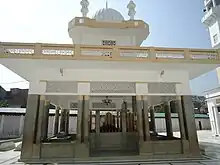Saidu Baba
Akhūnd Abdul Ghaffūr (1794–1876; also known as Saidū Bābā and the Akhund of Swat) was a prominent religious saint and founder of the state of Swat. The city of Saidu Sharif, that serves as the administrative capital of Swat District, is named after him.
Akhund Abdul Ghaffur Saidu Baba | |
|---|---|
 Tomb of Saidu Baba | |
| Born | 1794 |
| Died | 1876 |
| Resting place | Saidu Sharif |
| Known for | founding the state of Swat |
Early life
He was born in 1794 in Jabri village of Shamizai area in the Upper Swat region. He belonged to a non-Pashtun Gujjar[1][2][3][4][5] or Safi[6] family in the upper Swat Valley.[7] After completing the initial stages of education, he left home and studied from Maulana Abdul Hakeem in Gujjar Garhi, Mardan District. He then moved to the Chamkani area of Peshawar and then to the Ziarat Kaka Sahib area of Nowshera. Further, he stayed with Hazrat Ji Sahib in Peshawar and finally spent some time in the service of Maulana Muhammad Shoaib in Tor Dheri, District Mardan. He returned to his Swat in September, 1835 at the age of twenty four. At first, he stayed in a mosque in Maloch area of Swat. From there, he moved to Rangela. Then he stayed at the shrine of Ghazi Baba (Pir Khushal) near the historic village of Odigram in Swat and later took the path to the beautiful valley of Murghazar. From there, he settled in a village named Spalbandi near Murghazar. He got married there and in 1845 left this place and settled permanently in Saidu Sharif.
Battles
In 1831, when the Muslim reformist Syed Ahmad Barelvi died fighting in the battle of Balakot against the Sikh Empire along with hundreds of Mujahideen, many of his followers came to Buner to stay under the protection of Saidu Baba. They started a new uprising against the British Raj under Saidu Baba's leadership in 1862.[8]: 42 In 1834, Saidu Baba cooperated with the Afghan emir Dost Mohammad Barakzai in the battle against the Sikh Empire and brought a number of Ghazis and Talibs in the battle of Peshawar. In return, the Afghan Emir recognized Saidu Baba as ruler of Swat, Lundkhwar and Mardan. Afterwards, Saidu Baba became the most prominent spiritual leader among the eastern Pashtuns. Eventually, when Saidu Baba was about 43 years old, he permanently settled in Saidu Sharif and turned it into a thriving city.
In 1863, Saidu Baba led the Yusufzai and other groups in a battle at the Ambela Pass against the British forces, inflicting a decisive defeat upon them in Swat.[9]
Establishment of the state of Swat
In 1849, Saidu Baba nominated Sayyid Akbar Shah, a descendant of Pir Baba, as emir of the state of Swat. After Akbar Shah's death in 1857, Saidu Baba assumed control of the state himself till his own death in 1876.[8]: 40
Death
When Saidu Baba died in 1876, the London newspapers published a brief note mentioning his death. The general public of London did not know anything about him or Swat, and this unfamiliarity prompted the poet Edward Lear to write a nonsensical poem titled "Who, or why, or which, or what, Is the Akond of Swat?", highlighting the "otherness" of the region to the English people.[10]
Literary allusions
- Edward Lear's "The Akond of Swat"
- George T. Lanigan (1846–1886) wrote "The Ahkoond of Swat" on hearing of Saidu Baba's death in 1878.
- Ken Nordine's rendition of the Lear piece in his 'Word Jazz' radio show.
References
- Roy, Olivier (1990). Islam and Resistance in Afghanistan. Cambridge University Press. p. 60. ISBN 978-0-521-39700-1.
- Ziad, Waleed (16 November 2021). Hidden Caliphate: Sufi Saints Beyond the Oxus and Indus. Harvard University Press. p. 227. ISBN 978-0-674-24881-6.
...Akhund of Swat... was arguably the region's most beloved personality of the nineteenth century. Originally from a poor family of Gujjar pastoralists, at age eighteen he devoted himself to religious studies.
- Edwards, David B. (2 October 1996). Heroes of the Age: Moral Fault Lines on the Afghan Frontier. University of California Press. p. 255. ISBN 978-0-520-20063-0.
- Beattie, Dr Hugh; Beattie, Hugh (16 December 2013). Imperial Frontier: Tribe and State in Waziristan. Routledge. p. 312. ISBN 978-1-136-83957-3.
- McMahon, A. H.; Ramsay, A. D. G. (1981). Report on the Tribes of Dir, Swat, and Bajour Together with the Utman-khel and Sam Ranizai. Saeed Book Bank. p. 22.
- Haroon, Sana (2011). Frontier of Faith: Islam, in the Indo-Afghan Borderland. C. Hurst (Publishers) Limited. p. 39. ISBN 978-1-84904-183-6.
- Inam-ur-Rahim; Viaro, Alain M. (2002). Swat: An Afghan Society in Pakistan : Urbanisation and Change in Tribal Environment. City Press. pp. 77–79. ISBN 978-969-8380-55-7.
- Haroon, Sana (2011). Frontier of Faith: Islam, in the Indo-Afghan Borderland. Hurst Publishers. ISBN 978-1849041836.
- Sabir, Muhammad Shafee (2005). "Akhund Sahib Swat". Khyber.ORG. Archived from the original on 13 March 2016.
- Ziad, Waleed (16 November 2021). Hidden Caliphate: Sufi Saints Beyond the Oxus and Indus. Harvard University Press. p. 228. ISBN 978-0-674-24881-6.
External links
- Anon, "The (British Raj) Indian Frontier", The Times, Issue 29100, (15 November 1877); p. 4; col D.
- Our own Correspondent, "India", (Article contains the text: "The death of the Akhoond of Swat is announced"), The Times, No.29157, (Monday 21 January 1878), p. 5; col A.